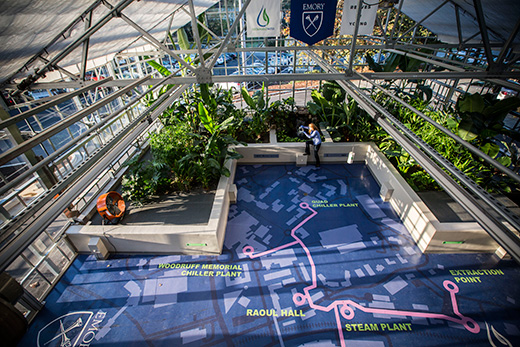Building upon a decade of advances in creating an environmentally sustainable campus, Emory's new Sustainability Vision and Strategic Plan is intended to amplify and strengthen the University’s role as an innovative leader in the field.
The new vision represents “a step forward in our long journey toward a sustainable campus and community, offering aggressive goals that move us far beyond where we’ve been and making sustainability an even deeper part of who we are as an institution,” says Ciannat Howett, director of Emory’s Office of Sustainability Initiatives.
“The pace of technology is changing rapidly regarding sustainability,” she says. “This plan allows us to think boldly and big about the future. We’ve pushed ourselves as a committee and a community to set our sights high.”
The plan builds upon foundational work launched over a decade ago to adopt sustainability as a guiding principle and inscribe it into Emory’s 2005-2015 Strategic Plan, says Peggy Barlett, Goodrich C. White Professor of Anthropology, who co-chaired the Sustainability Visioning Committee.
Since then, the University has garnered national acclaim for its pioneering innovations in green building, curriculum development, sustainable food procurement, and award-winning energy and water conservation efforts.
“As we took stock of what Emory has accomplished, the committee was impressed by the range and excitement generated by that list,” Barlett notes. “But at the same time, we still have challenges to rise to, thinking creatively about the next level up and how to engage more components of the University in our goals.”
The new plan continues that broad-based commitment, envisioning a campus that is a model of transformative practices and sustainable choices at every level, “from the copy room to the operating room, from the classroom to the residence hall.”
Supporting strategic action, creativity
To achieve that commitment, the plan outlines four strategic action arenas:
- Support culture change among academics, health care and operational units to carry forward courageous action on sustainability.
- Expand the network of sustainability champions to strengthen leadership at every level.
- Use Emory landscape, buildings and operations to model sustainable choices.
- Create strategic partnerships with local, national and international institutions to build flourishing and resilient communities.
Along with each action area, the plan also poses guiding questions, which are intended to stimulate creative thinking towards sustainability efforts among all Emory units, Barlett explains.
Those questions cover issues such as how to assess sustainability contributions, build expertise and share knowledge, stimulate new initiatives, and strengthen support for cultural change.
The plan also poses specific recommendations for achieving its goals. Ideas include strengthening faculty leadership through a rotating Faculty Fellows program, increasing the number of sustainability-related courses taught across campus by 25 percent by 2025, and creating a data hub and interdisciplinary laboratory to support campus-based sustainability research activities.
When it comes to energy consumption, the plan calls for setting the bar even higher, says Howett. While the 2005-2015 Strategic Plan called for reducing campus energy use per square foot by 25 percent — a goal Emory hit a year ahead of schedule — the new plan calls for the following:
- Reduce University campus energy use per square foot by 50 percent and total energy use by 25 percent (calculated with 2015 data baseline).
- Reduce Emory Healthcare energy use by 25 percent.
- Self-generate 10 percent of energy used on campus to replace fossil fuel sources.
- By using reconditioned water through the WaterHub, eliminate drinking-quality water for heating, cooling, toilet-flushing and other non-potable uses, with a goal to reduce Emory water use by 50 percent.
“One of the things that has always impressed me about Emory is that people here are not afraid of new ideas or trying something innovative even it it’s going to be hard, because we see the benefit,” says Matthew Early, vice president for Campus Services and a committee co-chair.
“I like that fact that these goals are difficult,” Early says. “It’s not an easy plan, and that excites me because I like a challenge. We can’t just rest on our laurels. With this plan, we’re pushing ourselves even further."
A community conversation
Work on the plan began in fall 2014, when Emory President-elect and Provost Claire Sterk and Executive Vice President Mike Mandl appointed a visioning committee to launch the process.
Their task was shaped through leadership meetings and campus-wide community conversations that yielded more than 200 suggestions, most of which were integrated into the final report.
“We turned to the Emory community with an invitation to dream big, looking for ways to really stimulate the imagination,” says Barlett. “And we’ve been delighted with the ways the document encourages new avenues for cooperation.”
Over the past decade, Barlett says she’s noted a profound cultural shift in public awareness and investment in sustainability efforts.
“It used to be that people really didn’t have any experience with these issues,” she says. “Now, as a society, all sectors are becoming much more aware and sophisticated about how they can contribute.”
Although the new plan is intended to guide Emory for the next 10 years, a midcourse review will be conducted after five years to ensure that the vision is still relevant and on target, Howett says.
For more information about sustainability initiatives at Emory or how to get involved with campus efforts, visit the Office of Sustainability Initiatives.

